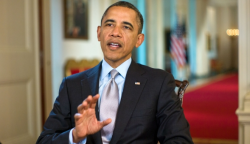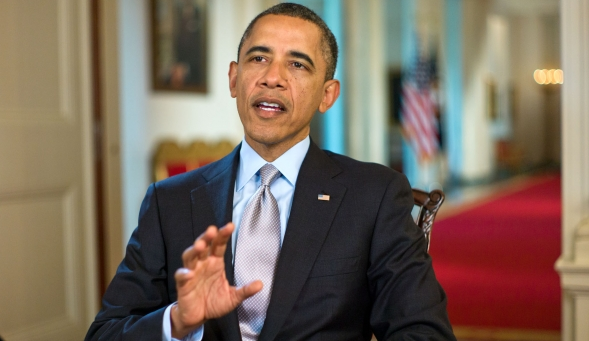
Photo by Chuck Kennedy/White House.
Cross-posted from Climate Progress.
You’ll be glad to know that in the last 12 months, that whole climate change problem went away. At least that’s the impression left from comparing President Obama’s 2012 Earth Day proclamation with the 2011 one.
Last year’s proclamation was pretty rousing on the issue of global warming:
Looking to the future of our planet, American leadership will continue to be pivotal as we confront the environmental challenges that threaten the health of both our country and the globe.
Today, our world faces the major global environmental challenge of a changing climate. Our entire planet must address this problem because no nation, however large or small, wealthy or poor, can escape the impact of climate change. The United States can be a leader in reducing the dangerous pollution that causes global warming and can propel these advances by investing in the clean energy technologies, markets, and practices that will empower us to win the future.
While our changing climate requires international leadership, global action on clean energy and climate change must be joined with local action.
Can’t argue with any of that. Sure, Obama isn’t doing bloody much on climate change, and he’s nonsensically censoring it from his major speeches even though it may be one of the definitive wedge issues of our time.
But at least one day a year, when people are focused on the environment, surely we can all come together and at least mention, in passing, without too much fanfare, in a meaningless proclamation, the gravest preventable threat to the Earth’s environment and humanity’s well-being. Yes we can — not!
Here’s the full 2012 proclamation:
On April 22, 1970, millions of Americans came together to celebrate the first Earth Day. Students, teachers, activists, elected officials, and countless others challenged our Nation to confront our most urgent environmental issues and rallied around a single message: the success of future generations depends upon how we act today. As we commemorate Earth Day this year, we reflect on the challenges that remain before us and recommit to the spirit of togetherness and shared responsibility that galvanized a movement 42 years ago.
America rose to meet the call to action in the months and years that followed the first Earth Day. We passed the Clean Air, Clean Water, Endangered Species, and Marine Mammal Protection Acts; founded the Environmental Protection Agency; and ignited a spirit of stewardship that has driven progress for over four decades. Today, our air and water are cleaner, pollution has been greatly reduced, and Americans everywhere are living in a healthier environment.
While we have made remarkable progress in protecting our health and our natural heritage, we know our work is not yet finished. Last July, my Administration proposed the toughest fuel economy standards in our Nation’s history — standards that will save families money at the pump, cut greenhouse gas emissions, and significantly reduce our dependence on oil. In December, we finalized the first-ever national standards to limit mercury and other toxic emissions from power plants, helping safeguard the health of millions. We have taken action to protect and restore our Nation’s precious ecosystems, from the Gulf Coast to the Great Lakes. And we continue to make landmark investments in batteries, biofuels, and renewable energy that are unlocking American innovation and ensuring our Nation stays on the cutting edge. Our country is on the path to economic recovery and renewal, and moving forward, my Administration will continue to fight for a healthy environment every step of the way.
As we work to leave our children a safe, sustainable future, we must also equip them with the tools they need to take on tomorrow’s environmental challenges. Supporting environmental literacy and a strong foundation in science, technology, engineering, and math for every student will help ensure our youth have the skills and knowledge to advance our clean energy economy. Last year, we launched the Department of Education Green Ribbon Schools recognition award to encourage more schools to pursue sustainability, foster health and wellness, and integrate environmental literacy into the curriculum. In the days ahead, we look forward to awarding the first Green Ribbons and recognizing the accomplishments of green schools across our country.
Forty-two years ago, a generation rallied together to protect the earth we would inherit. As we reflect on that historic day of activism and stewardship, let us embrace our commitment to the generations yet to come by leaving them a safe, clean world on which to make their mark.
NOW, THEREFORE, I, BARACK OBAMA, President of the United States of America, by virtue of the authority vested in me by the Constitution and the laws of the United States, do hereby proclaim April 22, 2012, as Earth Day. I encourage all Americans to participate in programs and activities that will protect our environment and contribute to a healthy, sustainable future.
IN WITNESS WHEREOF, I have hereunto set my hand this twentieth day of April, in the year of our Lord two thousand twelve, and of the Independence of the United States of America the two hundred and thirty-sixth.
Yes, they snuck in the phrase “cut greenhouse gas emissions” about fuel economy standards (though technically, the standards, by themselves, won’t cut our emissions, but merely slow their growth).
As A. Siegel notes in his excellent column on the proclamation:
… there is nothing there about why ‘cutting greenhouse gas emissions’ would be something that anyone should be concerned about on Earth (or any other or, well, more accurately, every other) Day.
There is simply no possibility of achieving the proclamation’s core aim — “let us embrace our commitment to the generations yet to come by leaving them a safe, clean world on which to make their mark” — without an explicit focus on climate change.
As the International Energy Agency (IEA) has said, we’re headed toward 6 degrees C (11 degrees F) of global warming. Even “a 4 degrees C future is incompatible with an organized global community, is likely to be beyond ‘adaptation’, is devastating to the majority of ecosystems, and has a high probability of not being stable,” explained Kevin Anderson, director of Britain’s Tyndall Center for Climate Change.
Heck, the IEA’s chief economist said of 6 degrees C warming, “Even school children know this will have catastrophic implications for all of us.” If only the White House communications team had some school children on it.




